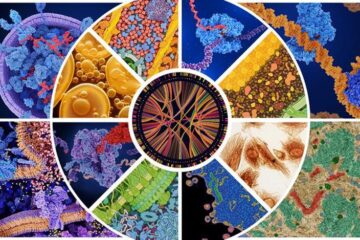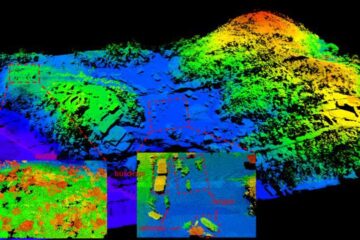Darkness unveils vital metabolic fuel switch between sugar and fat

Mediating molecule provides new research target for diabetes, obesity
Constant darkness throws a molecular switch in mammals that shifts the body’s fuel consumption from glucose to fat and induces a state of torpor in mice, a research team led by scientists at The University of Texas Medical School at Houston reports in the Jan. 19 edition of Nature.
While their findings could provide new insight into mammalian hibernation, researchers note that the pivotal metabolic signal that emerged from the dark also presents a new target for obesity and type 2 diabetes research. A series of experiments pinpointed 5-prime adenosine monophosphate (5’-AMP) as the key molecular mediator of the constant darkness effect, switching mice from a glucose-burning, fat-storing state to a fat-burning, glucose-conserving lethargy.
Active mammals – a bear foraging for food or a human running a marathon – also undergo a similar switch, burning glucose first to fuel their efforts, and as blood sugar is consumed, their bodies switch to burning fat.
“How does the body know when to switch? 5’-AMP is the signal. I believe it’s the same metabolic system, whether we are talking about hibernation or not,” said senior author Cheng Chi Lee, Ph.D., professor of biochemistry.
The team started with a basic question: What actually sets off hibernation? “These animals dig deep burrows,” said Lee, an expert in circadian rhythms. “They are constantly in the dark. Why not darkness as a switch?”
Mice do not hibernate but they can slip into a similar short-term state of torpor. Lee and colleagues started with a microarray analysis of gene expression in the livers of mice subject to the usual light-dark cycle and those kept in the dark for 48 hours.
One gene fired up in the dark – procolipase, which produces an enzyme (CLPS) required for degrading dietary fat. Expression of the gene previously was thought to be restricted to the pancreas and gastrointestinal tract. Yet messenger RNA for CLPS (mClps) was found in the livers of mice exposed to prolonged dark, an unexpected finding.
They repeated the experiment in mice with natural, or “wild type,” genomes and three strains of mutant mice with impaired circadian rhythms.
The wild-type mice and two of the mutant strains exposed to regular light-dark cycles showed no sign of the gene’s expression in their livers – it remained in the pancreas and stomach. The gene was expressed in the livers of some mice from a double-mutant strain that has absolutely no circadian response. All four genotypes of mouse kept in constant darkness had mClps expressed not only in their livers but in all peripheral tissue except the brain and kidneys.
“This is the first example of a gene that is turned on by darkness, where darkness itself is a signal,” Lee said. “Twelve hours of darkness didn’t do the job; it had to be at least 48 hours.”
Tests showed it subsequently took five to seven hours of light exposure to inhibit the gene’s expression in the liver. Taken together, these time delays pointed to the gene’s expression being mediated by something in the blood. Another lab test showed elevated levels of 5’-AMP in the blood of mice exposed to constant darkness compared to those kept in the regular light-dark cycle.
To confirm the connection, the team injected 5’-AMP into mice exposed to a regular light-dark cycle. Three to four hours after injection, mClps was expressed in the livers of these mice and further tests showed expression in all tissues except the brain.
Injecting mice with 5’-AMP’s more glamorous molecular cousins – adenosine triphosphate (ATP), adenosine diphosphate (ADP), both vital to providing energy to cells, and the signaling molecule cyclic AMP — did not produce the same effect.
The mice injected with 5’-AMP also were found to have a lower body temperature, a sign of torpor. Core body temperature measurements confirmed their lethargic state. Mice kept in constant dark also ate less, lost weight, and showed evidence of increased fat consumption, all hallmarks of hibernation in larger mammals.
The authors note that 5’-AMP has previously been shown to regulate enzyme activity for glucose usage and production. The brain requires glucose to function. By switching the primary source of energy in other organs from glucose to fat, 5’-AMP conserves glucose for brain function, the paper notes.
“5’-AMP is a pivotal metabolic signal whose circulatory level determines the balance of the peripheral organ energy supply between glucose, glycogen and fat,” the authors conclude, raising the longer-term possibility of 5’-AMP-based therapies for obesity or type 2 diabetes.
Media Contact
More Information:
http://www.uth.tmc.eduAll latest news from the category: Health and Medicine
This subject area encompasses research and studies in the field of human medicine.
Among the wide-ranging list of topics covered here are anesthesiology, anatomy, surgery, human genetics, hygiene and environmental medicine, internal medicine, neurology, pharmacology, physiology, urology and dental medicine.
Newest articles

A universal framework for spatial biology
SpatialData is a freely accessible tool to unify and integrate data from different omics technologies accounting for spatial information, which can provide holistic insights into health and disease. Biological processes…

How complex biological processes arise
A $20 million grant from the U.S. National Science Foundation (NSF) will support the establishment and operation of the National Synthesis Center for Emergence in the Molecular and Cellular Sciences (NCEMS) at…

Airborne single-photon lidar system achieves high-resolution 3D imaging
Compact, low-power system opens doors for photon-efficient drone and satellite-based environmental monitoring and mapping. Researchers have developed a compact and lightweight single-photon airborne lidar system that can acquire high-resolution 3D…





















